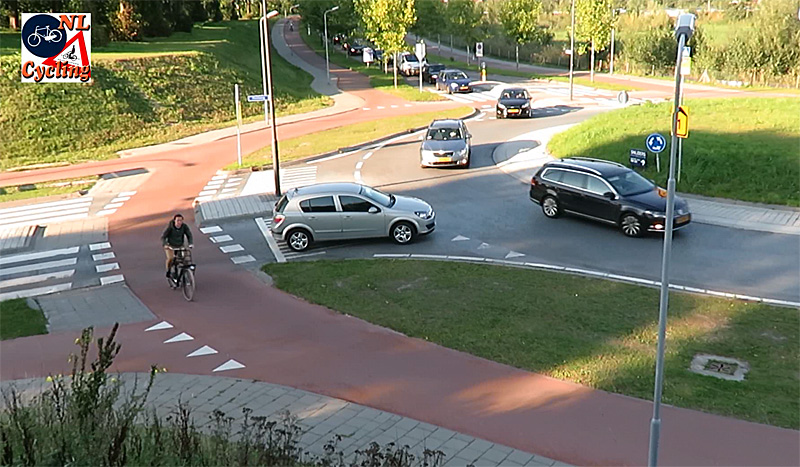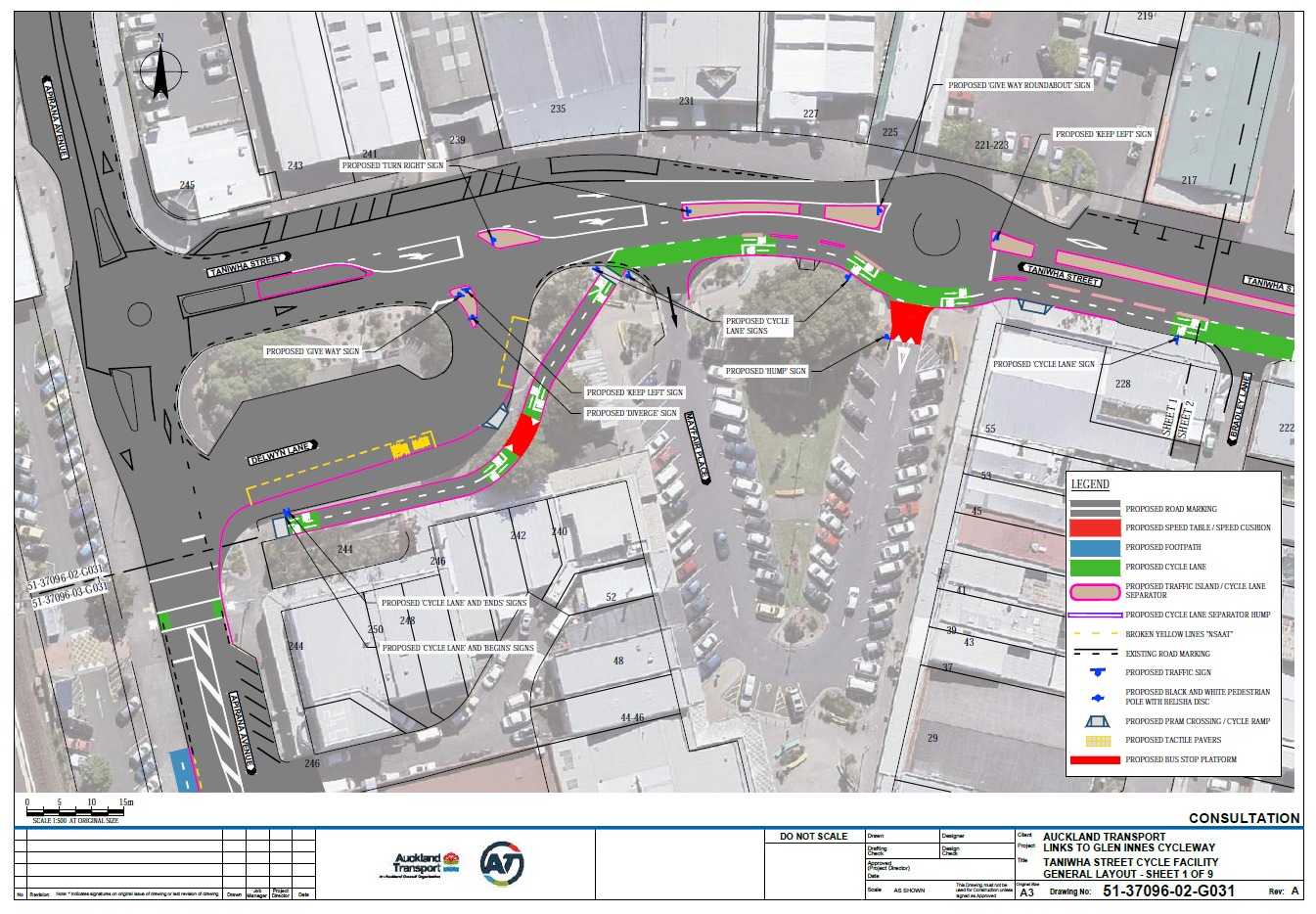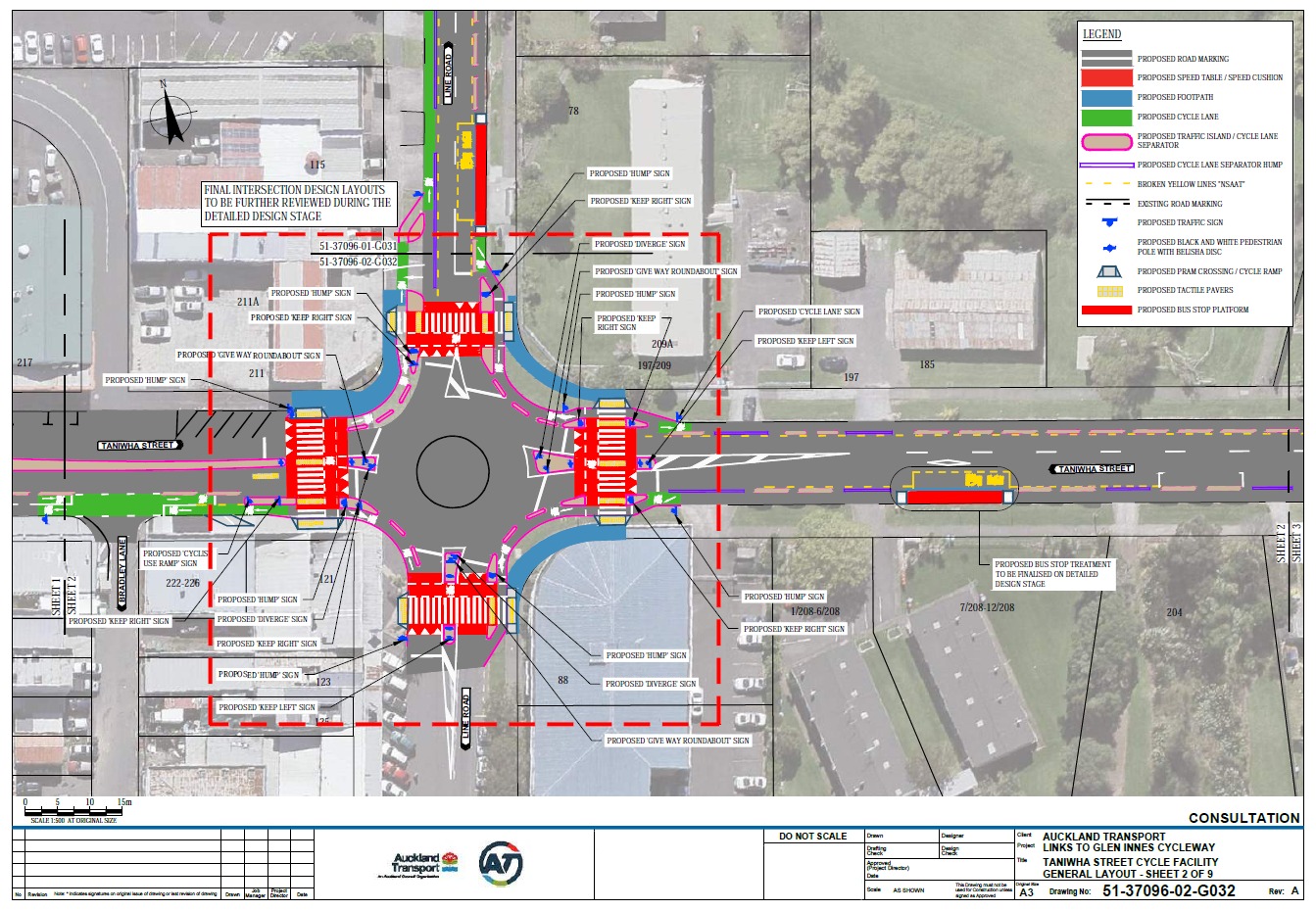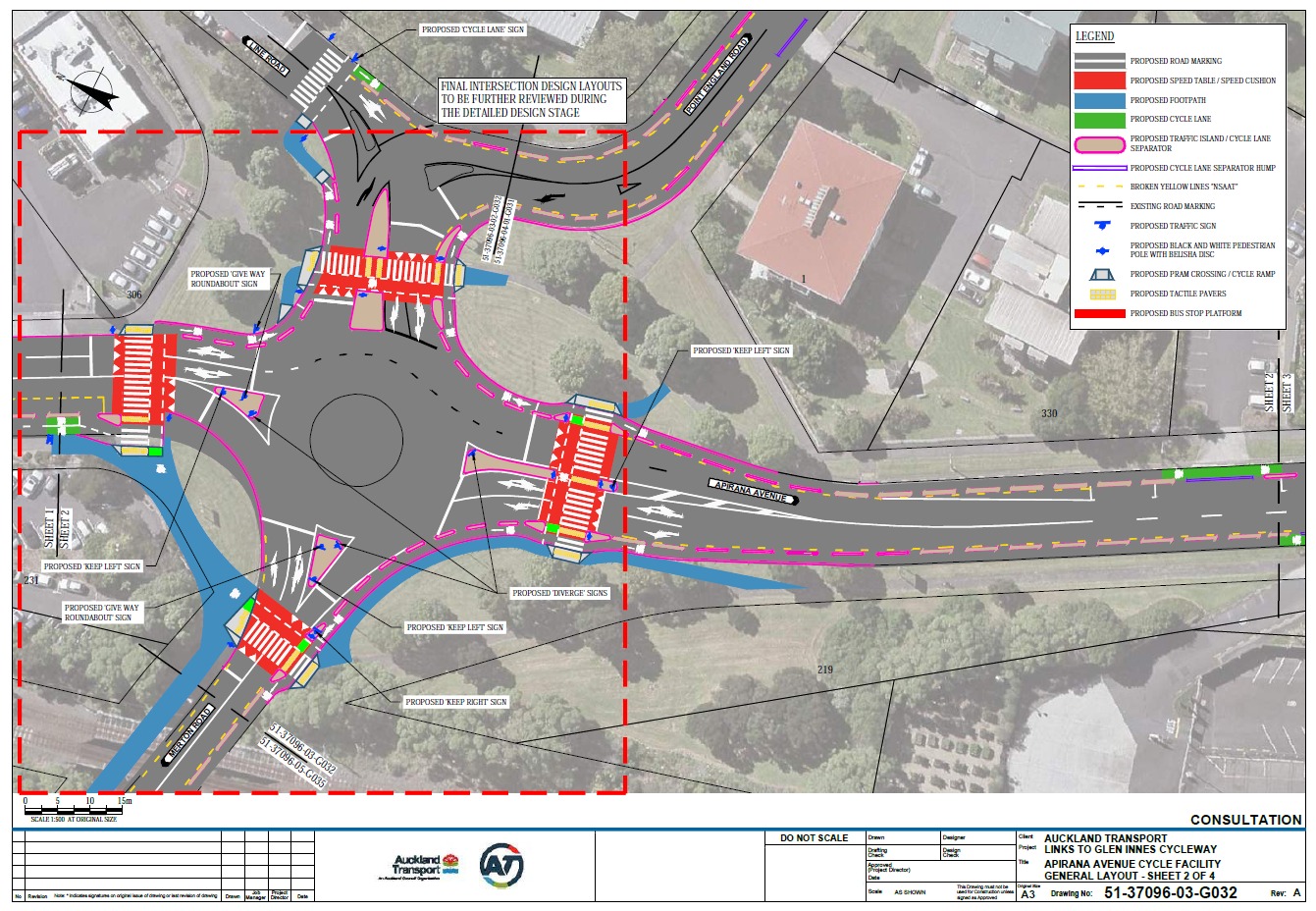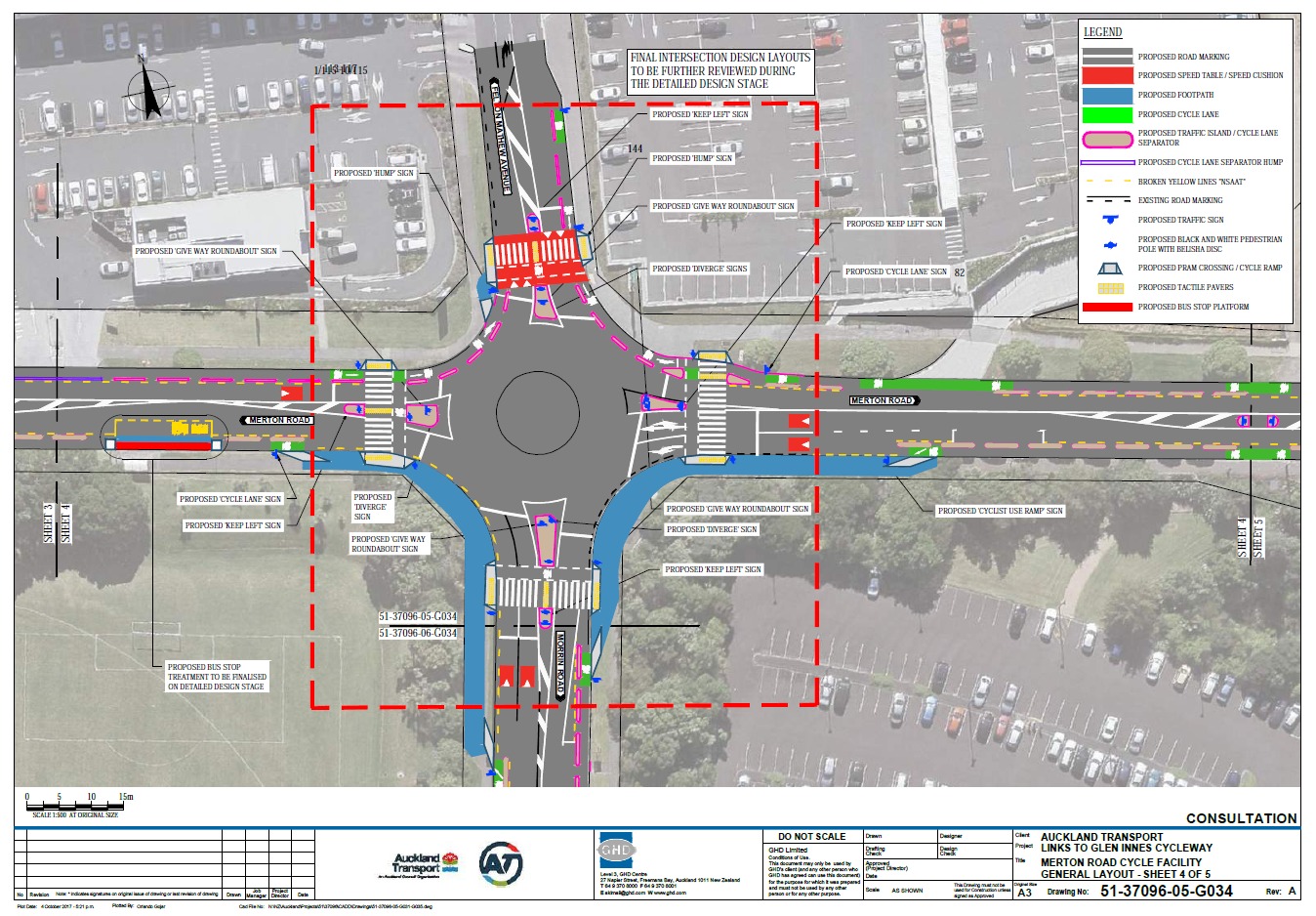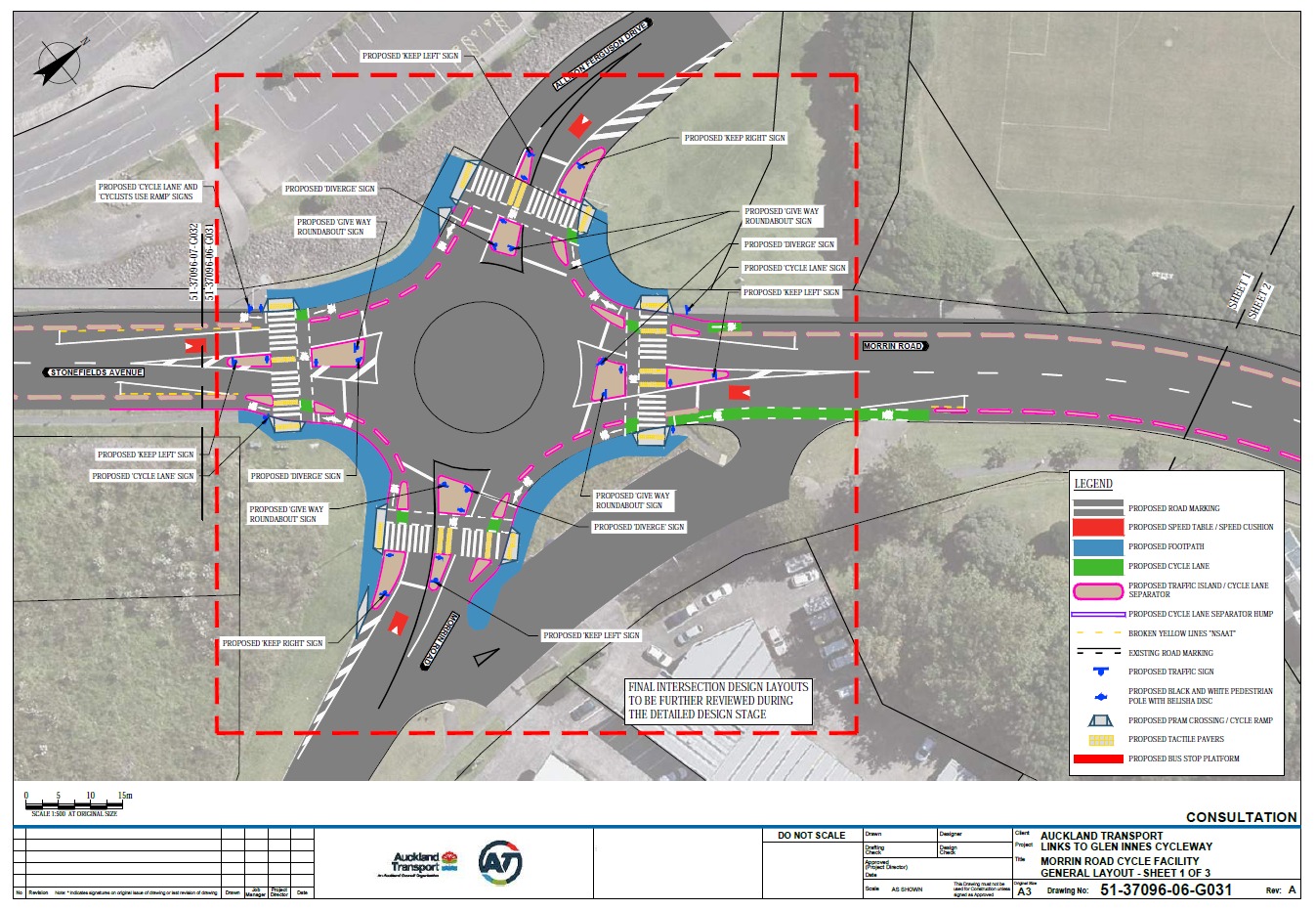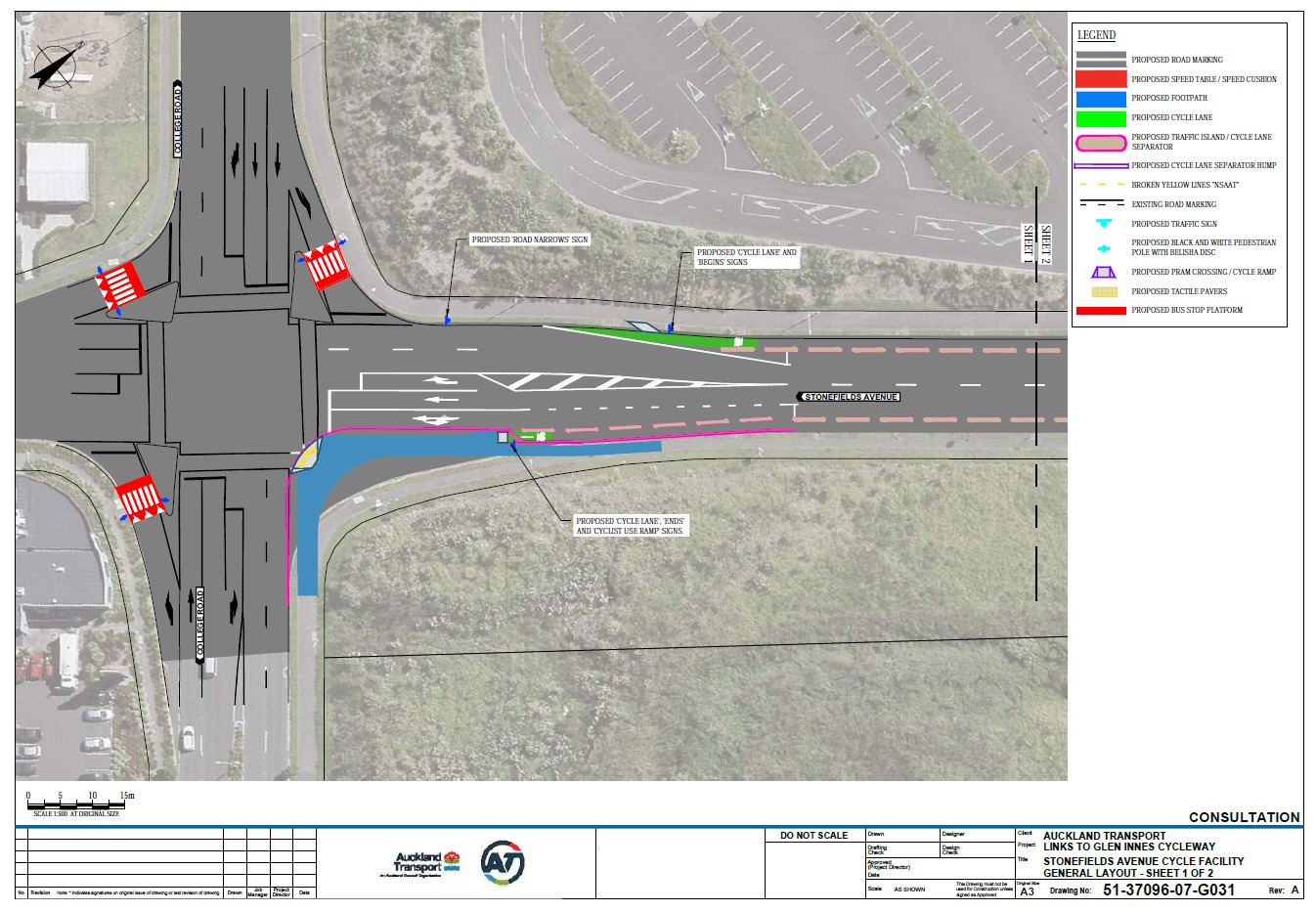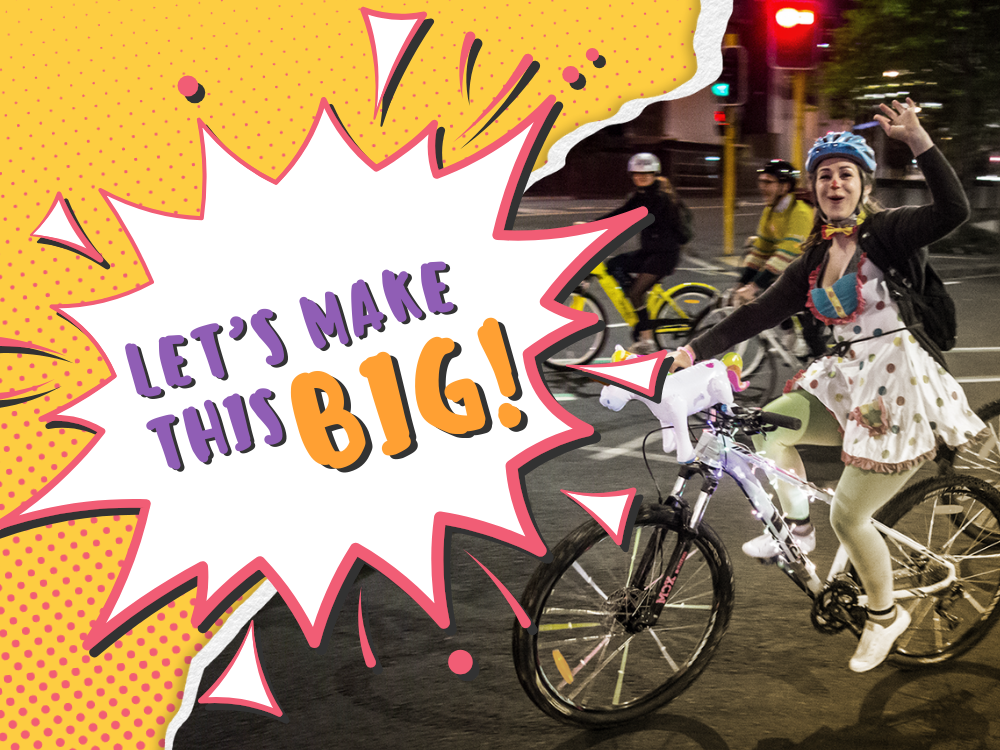Since we last blogged about the planned cycleways in Glen Innes, Auckland Transport has released detailed designs for the intersection improvements. They’re pretty advanced for New Zealand – our first ‘Dutch-style roundabouts’ – and we cover them in detail below.
Feedback on this project closes Wednesday October 25th! We’re hearing there’s some spirited opposition to car parking removal on some of the roads, so these cycleways really need your support.
Here’s the online form – and here’s what we’d say in response to the four feedback questions:
1. Would the Links to Glen Innes Cycleways encourage you to cycle more often in the area?
- Yes! Yep. Yessirree Bob. Darn tooting. Right?
2. What do you think of the cycleways?
- Support the solid separators that cannot be driven over, and sufficient door buffer space beside parking
- Support removal of parking where needed, so cycleways can be safe for beginners, children and casual riders
- Support the fact that routes radiate out from the town centre (i.e. starting in the middle and extending as far as budget allows)
- Support for improving hostile intersections, particularly the Big Four: the roundabouts at Merton Ave / Apirana Ave, Apirana Ave / Pilkington, Merton Ave / Morrins Road, and Taniwha St / Line Road
- [Updated] Support the ‘Dutch roundabout’ designs with speed tables and cycle crossings – as long as raised tables are strong, especially on the multi-lane roundabouts!
3. How would you improve the cycleways?
- Please enhance speed tables and traffic calming around the ‘Dutch’ roundabouts.
- [A great place to mention any local knowledge or concerns or priorities you may have]
4. Do you have any other comments or suggestions about the Links To Glen Innes Cycleways?
- Consider NOT upgrading the rail underpass north of the train station to become a cycleway. Why? Because the significant costs for changing the tunnel could be better spent on the other cycleway and intersection improvements proposed; and there are alternative routes.
And now for a closer look at those Dutch-style roundabouts…
Here are the eight intersections that’ll be improved as part of the project, which we’ll discuss one by one. (Note: the full set of plans as PDFs is also available directly on the AT website here.)
Intersection 1 – Apirana Ave/Taniwha St
This ‘intersection’ covers the connection from Line Road / Taniwha Street through the town centre to the train station and onward paths. As such, it has to move people past a whole set of smaller ‘intersections’, i.e. driveways and side roads.
AT has chosen to run the two-way cycleway along the southern side of Taniwha St because it has fewer cross-movements (and no angle car parks). Here, the cycleway crosses two one-way driveways (in and out of Mayfair Lane). Bradley Lane to the east has a solid median preventing the more dangerous right turns by drivers. And in the west at Delwyn Lane, the kerb will be significantly extended so bus passengers don’t disembark directly onto the cycleway.
Overall, we like this design, but will be asking for these tweaks:
- The entry into the Mayfair Place car park area is too wide and unprotected. This needs narrowing and speed bumps, to slow drivers crossing the cycleway. (The exit from Mayfair Place should work well given it’s one-way and will have a speed table).
- Similarly, a speed bump is also needed across the Bradley Lane entry, to slow down drivers turning across the cycleway.
Intersection 2 – Taniwha St/ Line Rd
And there it is. What may be the first ‘Dutch’ roundabout in New Zealand – with raised table crossings, protected circulation around the circumference, and cyclist priority across the side roads!
To finally see this proposed in a local context is pretty flipping awesome.
That’s not to say everything is quite as if it had been designed by someone from the Low Countries. Some details worth tweaking:
- The turns in the protected cycle lane are pretty tight – particularly the four ninety-degree turns if you’re making a right turn from one street into another. We can understand that Kiwi engineers are still a bit hesitant to let people on bikes zip smoothly through here, with drivers expecting priority and not expecting sudden turns by bikes, but…
- Let’s make those right turns a wee bit wider. Otherwise, riders won’t be able to stick to the indicated cycle areas on the raised tables, and instead will swing out onto the pedestrian zebras – not good for people on foot or on bikes.
- Also, if the turns are too tight and cyclists drift onto the pedestrian part of the zebra, they may also travel across the tactile warning pavers at an angle that may cause them to fall if the pavers are slippery in rain.
- This goes for ALL protected roundabouts discussed here: please make the raised tables wider (i.e. longer as the car flies) so there’s at least 1-2m more between the slow-down effect and the cycle crossing. This means a driver exiting the roundabout circulatory and only slowing down at the last moment won’t find themselves with their nose already in the cycle crossing area. This will also make it feel safer for riders and walkers.
- Lastly, the connection to the two-way cycleway on the western part of Taniwha Street isn’t really completely designed yet. Eastbound cyclists currently end up… heading into opposing traffic? This can be sorted by design and kerb changes, but clearly has not yet been allowed for.
Overall, assuming those slightly too-tight turns are resolved, this could be an awesome step change for roundabouts in New Zealand!
Intersection 3 – Taniwha St/ Elstree Ave
Another protected roundabout here – with the same (many) pros and (some) cons as discussed above. We’d add:
- Cyclists travelling south out of the roundabout onto Elstree Avenue should be given a longer transition for merging back into traffic. Currently this is a bit too sudden.
- Northbound drivers don’t seem to have enough width on the southern Elstree Avenue approach. This may just mean fixing a drawing detail at this stage.
Overall, another good one, assuming the previously mentioned issues with the tight turns are sorted in detailed design.
Intersection 4 – Apirana/ Merton/ Line/ Point England
Now this is the big one. Literally. A sort-of-five-armed octopus of traffic lanes, with numerous two-lane approaches. How have AT tried to marry New Zealand’s car-capacity traditions with better safety and convenience for cycling and walking?
First, raised tables and protected cycle lanes (good!). Less superb is the fact that the design keeps dual traffic lanes approaching and crossing several of the raised crossings. This is generally seen as a street design no-no, because if a driver in the first lane stops, and pedestrians / riders start crossing, they may well be hit by a driver in the second lane who doesn’t.
It seems AT felt that removing the extra lanes (to turn the raised crossings into single lanes) would be unacceptable (to them, or to the ‘typical’ driver) in terms of congestion. We know a traffic signal was considered here, but rejected. That’s likely because constraints like the rail overbridge limit the number of approach lanes on Merton Road, thus preventing the massively oversized signals that you’d need to replicate the traffic flow capacity of the roundabout.
Is this proposal acceptable? We feel (somewhat grudgingly) that it may be okay as long as:
- The speed tables are strong. STRONG as in: a significant raised table height and relatively steep ramp gradient. Safety here will utterly depend on all drivers slowing down, especially those who don’t expect to see – or don’t care to stop for – pedestrians and cyclists crossing.
- The Line Road zebra crossing also requires a raised table.
Overall, this is a compromise – but one that will still ensure a pretty decent change at this horrible intersection right at the edge of a town centre.
Intersection 5 – Apirana Ave/ Pilkington Rd
The smaller sibling of the previous roundabout, this one will see all two-lane approaches reduced to single-lane approaches – the basic safety approach we’d like to see everywhere pedestrians and cyclists are crossing roundabouts.
The design still offers a few questions:
- Why are raised tables only proposed on one approach? The safety benefits of slowing down traffic surely apply on all arms – and for some movements, such as Pilkington -> Apirana Avenue, the roundabout design and less-than-ninety-degree angle would still allow pretty fast turns by cars. Those movements should be slowed down to allow safe crossings.
- Riders who come from Pilkington Avenue should have a bypass to enter the cycle lane, rather than being squeezed back into the traffic lane. This seems an easy change.
- At the Tripoli Road approach, riders coming from the north are forced through a particularly convoluted turn. They’re effectively asked to do a 90-degree turn to the left, followed by an 180-degree U-turn to the right. We know Dutch roundabouts try to have riders approach the crossing at right angles for safety – but let’s do it without such convoluted detours, please.
Overall, not bad – but the lack of speed calming on the two bigger roads raises questions.
Intersection 6 – Merton Rd/ Morrin Rd
This one is another compromise. Some sections of shared paths – ugh – with multi-lane approaches retained on the eastern and southern approaches.
The design slows drivers down with speed cushions instead of tables (presumably because of current/future bus routes?), which might seem an acceptable swap at first glance.
However, drivers leaving the roundabout aren’t slowed down – and in current NZ roundabout designs, this is one of the more dangerous scenarios for people on bikes.
Also, like all the other protected roundabouts discussed here, this design asks right-turning cyclists to cross on dedicated bike priority crossings, via a 90-degree turn onto the crossing just after leaving the circulating lane at the edge of the roundabout. Driver aren’t used to this, and will be uncertain up to the last moment whether a cyclist will turn to cross right, or go straight. So this is really not a good time or place for drivers to speed up!
Our strong advice here:
- Change the speed cushions to speed tables OR provide equivalent effective traffic calming for the exits.
Overall, we’re unconvinced about this design as it currently stands. Needs work.
Intersection 7 – Morrin Rd/ Stonefields Rd
Here, we see the same issues as at Intersection 6 – particularly a lack of treatments to slow down drivers exiting the roundabout, albeit reducing the approaches to single lanes makes it a bit less scary. Here, we’ll be pushing for:
- Keep the reductions to single-lane approaches (even if there’s push-back)
- Add better exit traffic-calmin (as per Intersection 6), so people crossing aren’t hit by drivers speeding up as they leave the roundabout.
Intersection 8 – Stonefields Rd/ College Rd
The changes here are fairly minimal: removing a slip lane on the northern approach of Stonefields Ave; and adding raised-table zebra crossings for the other approaches. This will make it easier for people on bikes coming from Stonefields (suburb) to get to the new cycle lane on Stonefields (Avenue). It won’t transform this into a ‘bicycle intersection’, but for now, it’s a reasonable way to transition from the end of the cycleway project into the wider area.
Round and round we go…
These examples of New Zealand’s first Dutch-style roundabouts don’t quite match Dutch practice. And because our cycle movements are less predictable and drivers here are less likely to pay attention to riders, these designs will also not quite enjoy the same casual safety that reigns in the Netherlands.
Even so, this is a major step forward! We’d like to see the introduction of these designs go well, which is why we strongly recommend they’re improved with:
- strong raised tables on the crossings to slow drivers down
- easier and more predictable bike approaches onto the crossings. (On some roundabouts this will be difficult due to space constraints, but on others, like on Apirana Avenue, there’s significant space available.)
And as we come closer to seeing our first proper ‘bicycle roundabouts’ in New Zealand, here’s an example from the land where it all started. Note, this one has relatively tight turns, and yet it works:
In summary, we feel these changes for the better will be massive. And if we’re still asked to entertain some compromises, they’ll be on a much higher level than ever before. This is where we want to be moving to!
Please take 2 minutes to submit. These kind of changes could be the model for suburbs all around Auckland – let’s show AT we want more of this sort of thing. Here’s that feedback link again!
[Header image from Bicycle Dutch]

